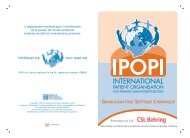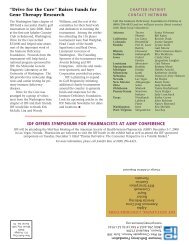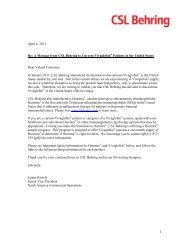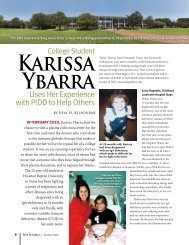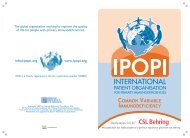IDF Patient & Family Handbook for Primary Immunodeficiency ... - IDFA
IDF Patient & Family Handbook for Primary Immunodeficiency ... - IDFA
IDF Patient & Family Handbook for Primary Immunodeficiency ... - IDFA
You also want an ePaper? Increase the reach of your titles
YUMPU automatically turns print PDFs into web optimized ePapers that Google loves.
Other Important <strong>Primary</strong> <strong>Immunodeficiency</strong> Diseases<br />
69<br />
Less Common <strong>Primary</strong> Cellular Immunodeficencies continued<br />
X-linked Immune Dysregulation<br />
with Polyendocrinopathy (IPEX)<br />
Syndrome<br />
IPEX is characterized by multiple autoimmune<br />
endocrine diseases (particularly diabetes and<br />
thyroid problems), chronic diarrhea and a rash<br />
resembling eczema. IPEX is associated with<br />
abnormalities of a gene on the X chromosome<br />
termed FOXP3. These boys have activated T-cells<br />
which stimulate autoimmune problems. Early<br />
immunosuppressive medications (cyclosporin or<br />
tacrolimus) followed by bone marrow transplantion<br />
are commonly used as treatments.<br />
Interferon-g/IL-12 Pathway<br />
Deficiencies<br />
These deficiencies are genetic disorders<br />
characterized by a special susceptibility to<br />
mycobacteria (the family of bacteria which cause<br />
tuberculosis and related infections) and salmonella<br />
infections. Many of the infants become ill as a<br />
result of a live BCG tuberculosis vaccination, given<br />
routinely at birth in many countries (not USA). Other<br />
patients have skin infections, swollen lymph nodes<br />
or blood stream infections with an enlarged liver and<br />
spleen. The illness results from a genetic inability<br />
to make interferon and/or IL-12, two proteins that<br />
are especially important in helping to kill these<br />
bacteria within the white blood cells. Several genetic<br />
<strong>for</strong>ms and several different molecular pathways are<br />
responsible. Treatment includes antibiotics and bone<br />
marrow transplantation.<br />
Natural Killer Cell Deficiency<br />
This is a rare disorder characterized by recurrent<br />
herpes virus infection and a selective deficiency<br />
of natural killer (NK) cells. Natural killer cells are<br />
lymphocytes (about 10 percent of the circulating<br />
lymphocytes) that are neither T- nor B-cells.<br />
Natural killer cells kill tumors and viral-infected<br />
cells and represent an early defense against<br />
cancer and viral infection. These patients may<br />
have recurrent or chronic herpes infections such<br />
as cold sores, severe Epstein-Barr virus infection,<br />
or varicella (chickenpox). Many of the patients<br />
require continuous anti-viral medicines.<br />
Less Common Phagocytic Cell Deficiencies<br />
The chief phagocytic white blood cell is the<br />
polymorphonuclear granulocyte (also known as<br />
neutrophil). To be effective, the neutrophil must<br />
move to a site of infection, ingest the organism<br />
and then kill the organism (see chapter titled<br />
The Immune System and <strong>Primary</strong><br />
<strong>Immunodeficiency</strong> Diseases).<br />
Neutropenias<br />
Neutropenias are disorders characterized by low<br />
numbers of granulocytes, usually defined as a<br />
neutrophil count of less than 500 cells/ul (normal is<br />
more than 2000 cells/ul). Depending on its severity<br />
and duration, neutropenia can lead to serious and<br />
fatal infection or intermittent infection of the skin,<br />
mucus membranes, bones, lymph nodes, liver,<br />
spleen or blood stream (sepsis).<br />
Neutropenia can occur at birth and can be<br />
life-long. One <strong>for</strong>m, termed severe congenital<br />
neutropenia (Kostmann syndrome), is an<br />
autosomal recessive disorder. This disorder is<br />
associated with a gene abnormality of G-CSFR or<br />
the receptor <strong>for</strong> G-CSF, a cytokine that stimulates<br />
granulocyte growth. These infants require G-CSF<br />
and may have bone marrow transplantation.<br />
Another <strong>for</strong>m of neutropenia is cyclic neutropenia<br />
which is an autosomal dominant disorder in which<br />
the neutropenia occurs every 2 to 4 weeks and<br />
lasts about a week. It is associated with a gene<br />
defect termed ELA-2.<br />
A third <strong>for</strong>m, benign chronic neutropenia, has<br />
low but not life-threatening neutropenia and is<br />
often asymptomatic. Treatment <strong>for</strong> all of these<br />
disorders may include antibiotics <strong>for</strong> infections,<br />
prophylactic antibiotics, G-CSF injections and<br />
bone marrow transplantation.








